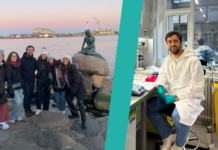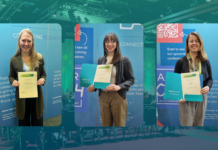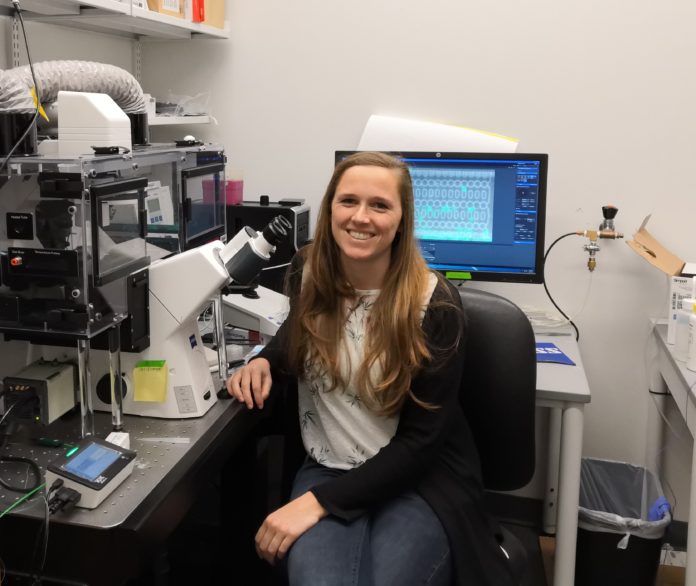
EACR Travel Fellowships are co-sponsored by Worldwide Cancer Research and provide funds up to €3,000 to early-career cancer researchers. For more information on how to apply for Travel Fellowships, you can visit the EACR website.
Name: Jessy van Asperen
Title: PhD Student
Home institute: Department of Translational Neuroscience, UMC Utrecht, Netherlands
Host institute: Weill Institute for Cell and Molecular Biology, Cornell University, United States
Dates of visit: 22 March – 25 April 2019
Other funding organisations who supported your trip: The Dutch Cancer Society
Research: Every cell in the body contains a miniscule skeleton, called the cytoskeleton. The cytoskeleton gives the cell support, structure and is required for cell movement and interaction with the cellular environment. Intermediate filaments are one of the three components of the cytoskeleton. In patients with glioma, a type of primary brain tumours, the composition of the intermediate filament network is changed. In my research, I try to gain a better understanding about the role of intermediate filaments in glioma malignancy, by mimicking these changes in a dish. Using three-dimensional models, we study how changing intermediate filaments affects the invasive capacities of glioma cells.
Why did you decide to apply for an EACR Travel Fellowship?
Visiting another lab is a great way to learn new techniques. I also applied so I could experience research in another country and build up a network in my field of interest. When I had the opportunity to visit Dr. Jan Lammerding’s lab, I decided to apply for the EACR Travel Fellowship in order to accommodate the costs associated with the visit. When I received the news that my application had been successful, I was delighted.
It was nice to be part of the Cornell community
Why did you choose the host lab?
In June 2018, I visited the Gordon Research Conference on Intermediate Filaments. During this conference, I discussed my research with Dr. Jan Lammerding. I discovered that the techniques developed in his lab were a great tool to answer some of the research questions of my project. We therefore decided to set-up a new collaboration and I had the opportunity to visit his lab at Cornell University for 5 weeks the past spring.
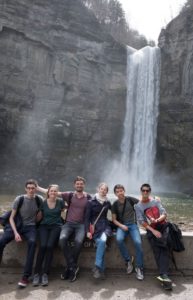
Can you summarise the research you did or what you learned on your visit?
During cancer invasion and metastasis, cells have to squeeze through narrow spaces when infiltrating the tissue. The nucleus is the stiffest organelle of the cell and deformation of the nucleus can be a rate-limiting factor during invasion. As part of Professor Elly Hol’s research group, I study how the intermediate filament (IF) network composition influences the invasiveness of cells. The IF network is involved in the translocation of the nucleus during migration. We hypothesized that changes in the IF network could affect the interaction with the nuclear envelope and therewith influence confined migration. During my visit, I learned and performed two high-throughput techniques to test this hypothesis on cell lines with modulated IF networks. Using microfluidic migration devices, I performed live-cell imaging to study migration of astrocytoma cell lines through confinement. In addition, I used microfluidic assays to measure the effects of IF composition on mechanical properties of the nucleus.
Describe a ‘typical day’ on your visit.
My day would start with a commute from my house in the town of Ithaca to the Cornell campus. The fastest way from my house to the lab was along a trail through a gorge with beautiful waterfalls; I cannot imagine a better commute to work than that! Once I arrived at the lab, I mainly balanced my time between cell culture and performing experiments at the microscope. In the beginning, I received lots of help from the other PhD students and postdocs in the lab, who showed me around and helped me set up experiments. Besides work in the lab, I took part in lab meetings, work meetings and attended seminars.
Did you take part in any interesting local/cultural activities?
I explored the Finger Lakes region in which Ithaca is located during my weekends. There are many gorges and waterfalls in short driving distance from Ithaca. My favourite trip was to Taughannock Falls State Park, a great hiking area and the location of the highest waterfall in the Eastern United States. The Finger Lakes region is also famous for its many wineries and in one of these wineries; we joined in a wine tasting class. During this class, we got to know many locals, which was a great way for us to learn more about the area.
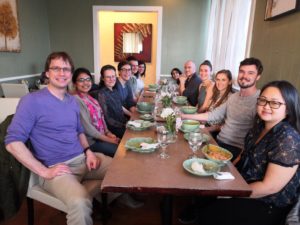
Was there anything you particularly liked about the host institution?
What I really enjoyed about my time at Cornell were the great number of interesting seminars. Every week there were many life-science related seminars. They were of high quality, with very good speakers. Another thing that I liked was the campus itself. The campus has a lot of history, great architecture and good facilities. It was nice to be part of the Cornell community for a couple of weeks.
Did you have a personal mentor or anyone who particularly helped you?
Dr. Jan Lammerding was a great mentor. He helped me with project planning, setting up the experiments, and ensuring that I knew about all the events going on campus and the things to do in Ithaca. I am also thankful to his lab members who taught me the techniques, and welcomed me as part of the group during the shared lunch breaks and other social events. There was a goodbye dinner with the whole group on my last day and it was a lovely ending to my visit.
Does your lab plan to do any future collaboration or publication with the host lab?
The visit to Cornell University was the start of a new collaboration that will continue upon return to my home institute. I will continue to use the microfluidic migration devices in my home lab and we will work together on follow-up experiments.
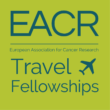 Interested in applying?
Interested in applying?
If you are interested in applying for the Travel Fellowship scheme, please click the EACR Travel Fellowships logo for more information.


